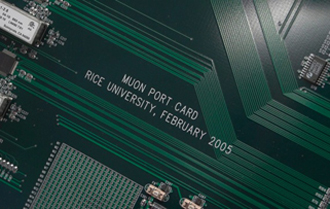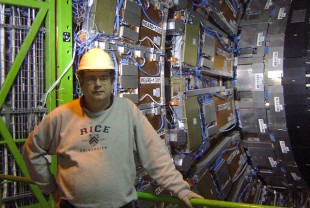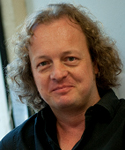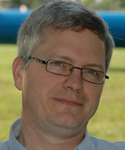Padley: ‘We’ve found a body, but we need to wait for the DNA results to declare it the Higgs’
Rice University physicists participating in the search for the elusive Higgs particle joined their colleagues at the European Organization for Nuclear Research (CERN) today in announcing the observation of a never-before-seen particle. The particle may turn out to be the Higgs boson or something new and equally important.
The search for the Higgs particle is at the heart of the most expensive science project in history — CERN’s $6 billion Large Hadron Collider (LHC). In an announcement today, LHC officials in Geneva, Switzerland, stopped short of declaring a victory in the Higgs search, saying instead that they have found a new particle with properties that make it a likely match for the supermassive Higgs particle.
“To use an analogy from CSI: We’ve found a body, but we need to wait for the DNA results to declare it the Higgs,” said Rice particle physicist Paul Padley, a co-investigator on the LHC Compact Muon Solenoid (CMS) experiment. “We’re not calling this the Higgs for the same reason the police don’t guess about the identity of a body. It’s our responsibility to be sure.”
The search for the Higgs particle marks a historic turning point in physics: The particle is the final unobserved piece of a puzzle called the Standard Model (SM), a model which jibes with every particle physics experiment ever performed. The Higgs, a type of particle known as a boson (pronounced “BOH-sahn”), is one of the linchpins of the SM.
“In our current understanding, all of the fundamental particles of nature get their mass through the Higgs mechanism,” said Frank Geurts, assistant professor of physics and astronomy at Rice and a co-investigator on the CMS experiment. “So, if we don’t find the Higgs particle — if that’s not there — then we seriously have to rethink why we exist at all.”
Padley, who returned to Rice from the LHC near Geneva late last week, said the search for the Higgs at LHC is one of the greatest endeavors in human history. “There are multiple experiments at LHC, and on the CMS experiment alone there are more than 3,000 scientists from 179 institutions in 41 countries. The experiment recreates conditions that existed in the first billionth of a second after the Big Bang.”
In addition to Padley and Geurts, Rice Department of Physics and Astronomy faculty co-investigators at LHC include Professor Jay Roberts, Assistant Professor Karl Ecklund and Assistant Professor Wei Li. More than two dozen Rice staff and students have also worked on the 13,000-ton CMS detector. For example, Rice physicists played a key role developing some of the electronic systems that sort CMS data in real time and select what to keep for future analysis. That’s no simple task because the CMS experiment produces 40 terabytes of data — enough to fill more than 8,500 DVD discs — each second. And a single run of the machine can last for weeks or even months.

Muon Port Cards designed and built at Rice act as information funnels at the LHC, where they take in and sort 25 gigabits of data per second to generate an output of 3 gigabits.
Rice personnel also contributed to the CMS pixel detector, which is like a 66-megapixel camera that snaps a photo 40 million times per second. Located just 4 centimeters from the head-on proton collisions in the LHC, the pixel detector records the trajectories of hundreds of particles that are produced in the collisions, and it helps sort through the debris of the collisions so that CMS physicists can reconstruct which particles are produced in any given collision.
Rice faculty, engineers, postdocs and students helped build and maintain some of the electronics that mine collision data in real time and flag collisions, which are often referred to as “events,” that should be saved for future analysis. These stored events provided the data that scientists needed to confirm today’s announcement about the likely candidate for the Higgs particle.
“The science unveiled today could not have happened without Rice’s hardware and software as well as hundreds of other critical components that were conceived and created at universities and national laboratories the world over,” said Ecklund, who is at CERN for today’s announcement.
Ecklund, Geurts and Padley, who have each devoted many years to the search for the Higgs boson, say the only prospect more exciting than finding the long-anticipated Higgs is finding something completely unexpected.
“When I was a physics undergraduate, we were taught that the expansion of the universe was slowing,” Padley said. “Whether or not the universe would one day collapse upon itself was an open question, and the Hubble Space Telescope was launched, in part, to answer that question.
“What the Hubble found was utterly shocking,” Padley said. “The Hubble found the universe was expanding faster and faster every second. It was completely new and totally unexpected knowledge, and that is exactly the sort of unpredictable discovery we expect to find with the LHC once it ramps up to full power.”
Read about Rice’s long history with CERN:
https://news2.rice.edu/2012/07/04/rice-has-long-history-with-cern/





Hi, I do enjoy the way you have framed this specific issue plus it does. Thank you for this excellent piece and I really do agree with the idea.